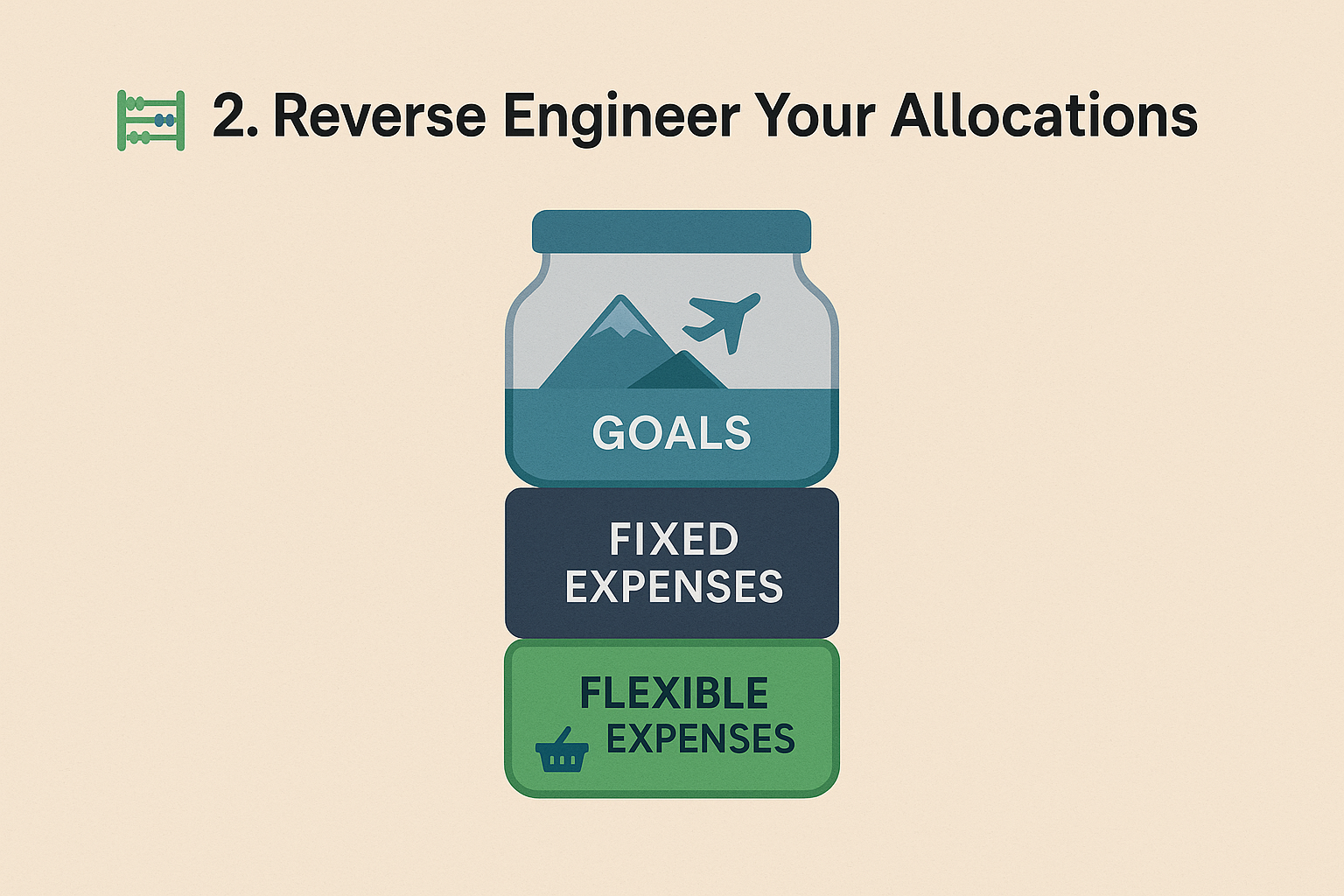🎯 Lesson Objective:
In this lesson, you’ll create a simple yet powerful system to route your income into the right accounts—automatically. You’ll define how your dollars move each month from paycheck to purpose, ensuring every dollar works for you with minimal manual effort.
🏁 1. Start With Your Take-Home Pay
Before you can build a money flow system, you need to know exactly what’s flowing in.
What to Do:
Look at your most recent pay stub and identify your net pay — what lands in your bank account after taxes, 401(k) contributions, health premiums, and other withholdings.
If you have variable income (like freelance work or side hustles), calculate an average monthly income using the past 3–6 months.
If you have a partner and you’re combining finances, do this for both incomes.
Why It Matters:
Designing an efficient flow depends on predictability. You can’t automate what you haven’t measured. Your net income is the “fuel” your system will distribute, so you need to get this part right.
🧮 2. Reverse Engineer Your Allocations
With your income known, now decide where your money should go each month—before it has a chance to slip through the cracks.
What to Do:
Start with fixed expenses: rent/mortgage, utilities, debt payments, insurance, etc.
Next, fund your financial goals:
Retirement accounts (e.g., Roth IRA, 401(k) if not deducted at work)
Emergency fund
Travel, gifts, large purchases
Finally, assign guilt-free money to flexible categories like dining out, entertainment, hobbies, etc.
Frameworks You Can Use:
50/30/20 Rule: 50% needs, 30% wants, 20% savings/investments.
Values-Based Budgeting: Allocate based on what brings you joy or peace of mind.
Why It Matters:
When you reverse engineer your spending based on priorities—not leftovers—you ensure that your goals are funded first, not last.
🏦 3. Set Up a Hub-and-Spoke Bank Structure
Think of your bank accounts like an airport: one central hub where money lands and smaller spoke accounts for each “flight path” your dollars need to take.
What to Do:
Use one main checking account as your hub. This is where your paychecks get deposited.
Create dedicated spoke accounts for:
Recurring bills (rent, utilities)
Savings goals (vacation, emergency fund)
Investments (a connected brokerage account)
Personal spending (optional: a separate debit card just for fun money)
Example Setup:
| Account | Purpose |
|---|---|
| Checking (Hub) | Receive income |
| Bills Account | Rent, subscriptions, etc. |
| Fun Account | Dining out, hobbies |
| High-Yield Savings | Emergency fund, short-term goals |
| Brokerage Account | Investing outside of retirement |
Why It Matters:
Separation creates clarity. It makes it easier to visualize your financial priorities and prevents you from overspending just because all your money is in one pile.
🔁 4. Automate the Flow With Transfers
Now that the structure is built, it’s time to let automation do the heavy lifting.
What to Do:
Set up automatic transfers from your hub account to each spoke account as soon as your paycheck hits.
Schedule transfers to align with your payday (e.g., every 2nd and 16th of the month).
Link to external accounts if needed (e.g., Fidelity or E*TRADE brokerage).
Example Flow:
Payday: $5,000 lands in Hub
Day after payday:
$1,200 to Bills Account
$500 to Roth IRA
$300 to Emergency Fund
$300 to Fun Account
Remaining stays in Hub for buffer or miscellaneous needs
Optional Tools:
Bank automation settings (Ally, Capital One 360, etc.)
Third-party automation tools (e.g., Monarch Money, YNAB, or even IFTTT-style workflows)
Why It Matters:
Automated systems remove decision fatigue. They prevent you from skipping savings or forgetting to invest because life got busy.
📊 5. Review and Adjust Monthly or Quarterly
Even a great system needs periodic tuning. Your priorities and income will evolve—your flow system should too.
What to Do:
Once a month or quarter, check:
Are transfers happening as planned?
Are any accounts consistently overdrafting or underfunded?
Did any bills change? Did you get a raise?
Use a budget tracking app or spreadsheet to quickly review account balances and category spending.
Questions to Ask:
Am I making progress toward my savings goals?
Is any account growing too large (a sign to invest)?
Is my fun money realistic or causing friction?
Why It Matters:
Even automated systems need maintenance. Regular reviews make sure your money flow still aligns with your life.
🎯 Lesson Recap
1. Start with Your Take-Home Pay
Get clear on what actually hits your bank account after taxes and deductions. This is the foundation of your system.
2. Reverse Engineer Your Allocations
Decide where every dollar should go—before the month begins. Fund your goals, cover your needs, and carve out guilt-free spending.
3. Use a Hub-and-Spoke Bank Setup
Centralize your income in one checking account (hub), then distribute it to purpose-driven accounts (spokes) for bills, savings, and investing.
4. Automate the Flow
Set up automatic transfers that trigger on payday. This removes friction and guarantees consistency.
5. Review Regularly
Check in monthly or quarterly to adjust for changes in income, expenses, or goals. Your system should evolve with you.
🧠 Quick Quiz
-
Calculating your take-home pay.
-
Decide where your money should go before you spend it.
-
It receives your income and routes money to other accounts.
-
To eliminate the temptation to spend before saving.
-
Monthly or quarterly.
⏭️ Up Next: Unlocking Hidden Roth Opportunities
In the next lesson, we’ll go beyond the basics and explore two powerful strategies the wealthy use to supercharge their retirement savings:
Backdoor Roth IRAs – A legal workaround for high earners who are locked out of contributing directly to a Roth IRA.
Mega Backdoor Roths – A 401(k) trick that allows you to convert even more money into a Roth, sometimes up to $66,000/year.
If you’ve ever thought, “I make too much to contribute to a Roth,” think again.
These two tactics can permanently shield thousands from future taxes.
Ready to level up? Let’s dive in.





